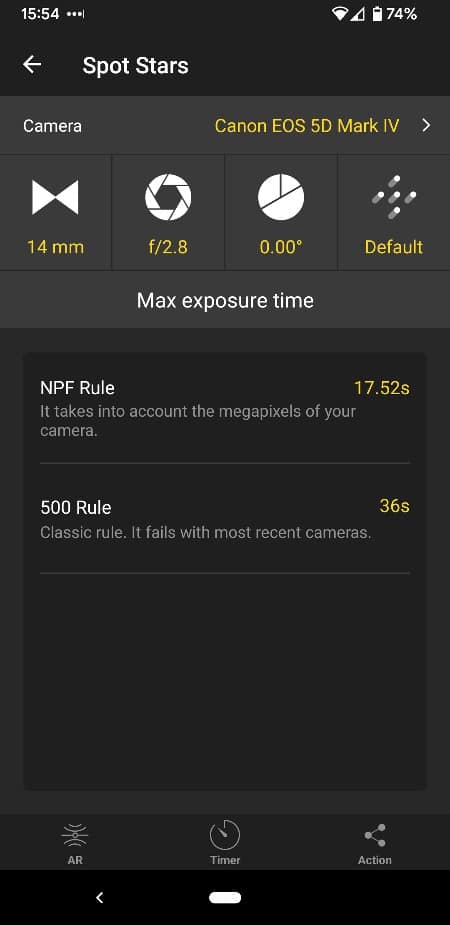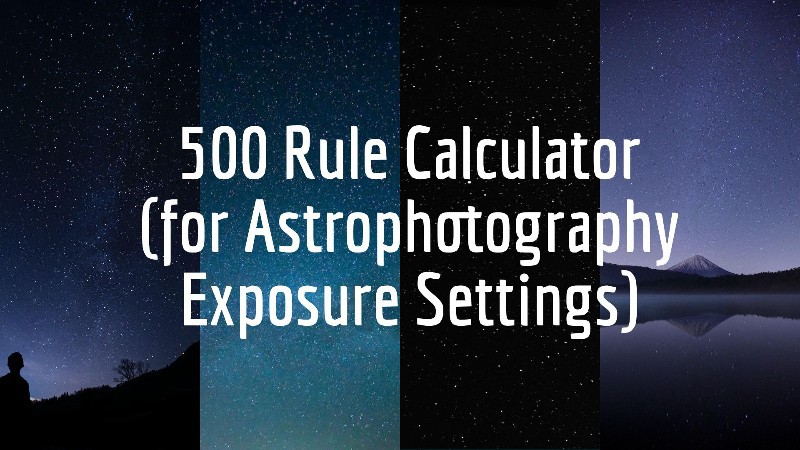The 500 Rule for Astrophotography is a quick and simple way to work out the exposure time you should use on your camera settings when taking a photo of the night sky.
You can use our free 500 Rule Calculator here:
500 Rule Calculator
Enter your lens focal length and select your camera's sensor size to calculate recommended exposure time.
How to Use the 500 Rule Calculator
You need to enter two pieces of information to calculate your recommended exposure time with the 500 rule:
- Enter the focal length of the lens you are using. For example, if you are using a 14mm lens, enter “14”.
- Select whether your camera’s sensor is Full-Frame or APS-C.
If you don’t know your camera’s sensor size, don’t worry. You can simply Google it, for example, “Nikon Z6 sensor size”. Or you can use a resource like the Digital Camera Database.
You can then press ‘calculate’ and get your recommendation.
What is the 500 Rule in Photography?
The 500 Rule is a simple calculation that estimates the shutter speed setting you should use on your camera when taking photos of stars and the night sky.
This is needed because:
- To photograph the stars you need to take a long exposure to capture enough light, but
- If this exposure time is too long the stars will blur because the Earth is rotating when you are shooting and so the stars “move”.
Therefore you need to estimate the maximum exposure time you can use to capture the most light, but before any blurring or trailing of the stars occurs.
The formula for the 500 rule is:
500 / focal length of lens = exposure time (in seconds)
500 Rule for Crop Sensor Cameras
The above formula assumes that you have a full-frame sensor camera.
If you have a crop sensor camera then the formula is:
500 / focal length of lens / 1.6 = exposure time (in seconds)
With our calculator, you can select whether your camera is full-frame or APS-C (cropped).
For crop sensor cameras, the exposure time will be reduced. This is because the cropping results in a narrowing or the field of view and an increased effective magnification and this exaggerates the star trailing.
Who is the 500 Rule for?
The 500 rule is for landscape astrophotography using a regular DSLR or mirrorless camera and a regular camera lens.
This is as opposed to deep sky astrophotography using dedicated astronomy cameras and astrophotography telescopes.
Therefore, if you are planning to shoot the night sky or Milky Way with a regular DSLR or mirrorless camera then the 500 rule should be a good starting point for you.
FAQs: 500 Rule Photography
What is the 600 Rule for Astrophotography?
There are other variations of the 500 rule for astrophotography, including the:
- 200 Rule
- 300 Rule
- 400 Rule
- 600 Rule
These are all just the same formula but use a different number as the base.
For example, the 600 Rule is:
600 / focal length of lens = exposure time (in seconds)
However, the 600 Rule is even more guilty of overestimating your camera’s capacity.
For example, with a 15mm lens this would recommend 40 seconds, which is way too much.
The reason why some use 200, 300, or 400 in the calculation is that it gives a better estimate of what shutter speed settings to use before star trailing occurs.
Using these different rules with a 15mm lens would give you:
- 200 Rule = 13 seconds
- 300 Rule = 20 seconds
- 400 Rule = 27 seconds
- 500 Rule = 33 seconds
- 600 Rule = 40 seconds
Which is most accurate? You can only find out by experimenting, but this leads us on to the NPF Rule.
What about the NPF Rule?
The NPF Rule is a more accurate calculator than the 500 Rule and takes account of the sensor resolution of the specific camera you are using.
For that reason, you have to enter more information to get your result. This includes Pixel Pitch of your camera, which you will likely need to look up.
We do also have a free NPF Rule Calculator that you can use.
What is better: the 500 Rule or the NPF Rule?
In short, the NPF Rule gives you a more accurate recommendation but requires more information to be inputted to get the result.
The 500 Rule is less accurate and tends to overestimate the maximum exposure you should use, but it is very quick and easy to calculate, especially if you are already out in the field and cannot find out the necessary information.
You can see how the 500 Rule and NPF rule compare here in the PhotoPills app:

Here you can see that for a Canon EOS 5D Mark IV camera with a 14mm lens at f/2.8:
- The NPF Rule says 17.5 seconds
- The 500 Rule says 36 seconds
The NPF Rule is the best one to follow as it accounts for the high sensor resolution of the camera.
However, these are both just guidelines and every astrophotographer needs to experiment with their camera and lens to work out what shutter speed, aperture, and ISO settings work for them.
You can also take into account what your plans for the image are, for example:
- If it is for sharing on a mobile platform like Instagram then you can afford a longer exposure time as any trailing will be less visible on smaller screens anyway.
- If you are planning on blowing up the image large, either for print or just on a platform where others will zoom in close and examine the details, then you would want a shorter exposure time to make sure everything is sharp.
Using the 500 Rule for Astrophotography
The 500 Rule is a great way of knowing where to start with your shutter speed settings when photographing the stars and Milky Way in the night sky.
It is less accurate than the NPF Rule, but it is quicker and easier to calculate on the go.
Overall, both the 500 Rule and NPF Rule are just guidelines and for the best results you will need to play around with your settings and find what works for you.
You will also be figuring out the right ISO and other settings for the best results and a lot of this can only be done with practical experimentation.
Related articles:




Thanks so much, for your free material. As a retiree with limited funds I greatly appreciate your generosity & only wish that i could afford to support you further.
You’re welcome Peter! I’m glad you find it useful.